Long post alert! Also if you're on a mobile phone you probably want to turn it sideways.
Tuesday 7th September
For my second Open House London 2021 trip I decided to follow the self guided walk around Barons Court and West Kensington. It was nice day for a wander around a mainly Victorian bit of West London. Pictures by me, words mostly by The Fulham Society who devised and published the route.
  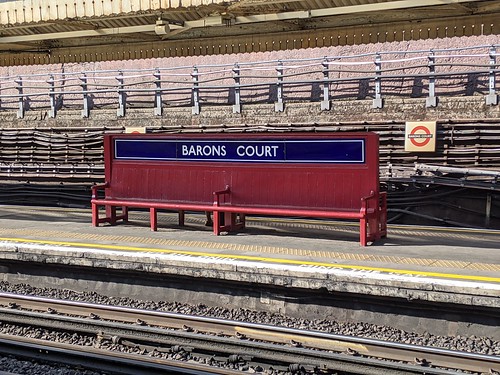 |
Barons Court Station (1905 for the District
Railway). Listed. The façade has fine tilework and Art Nouveau lettering. When the track was laid out in 1874 the area was still farmland, however by 1905, when the station was built, it was sufficiently developed to warrant a station of its own.
Nice green glazed tiles in the ticket hall and unique bench and sign combinations on the platforms. From the station entrance turn left and then left again onto Talgarth Road. |
|||
 |
135-49 Talgarth Road – St Paul’s Studios (1891 by Frederick
Wheeler) ‘designed for bachelor artists’. 149 was lived in by
Margot Fonteyn and 151. Colet House, (1885) was built for Sir
Coutts Lindsay, founder of the Grosvenor Gallery) and used by
Burne-Jones for his largest painting, The last Sleep of Arthur in
Avalon, which is now in Puerto Rico.
I can't imagine an artist wanting to work here now though alongside the very noisy A4 Talgarth road. Go back round and past the station entrance and turn right into Barons Court Road which leads into Margravine Gardens. | |||
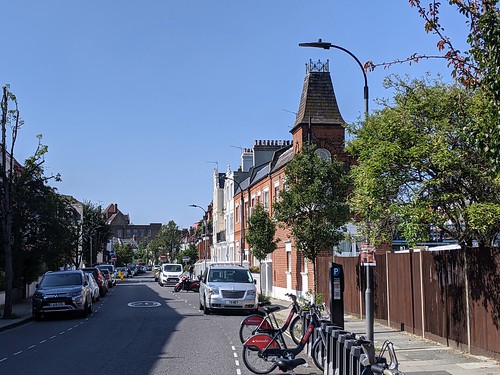 |
Nos 2-6 Margravine Studios (1890 Gibbs & Flew); Nos 6-12,
houses related to the Studios (1890 Gibbs & Flew). The terrace
has a distinctive turret. No 5, also built as a studio (1887/8
Harris and Wardrop), is a single storey building with the large
distinctive studio window. Although I'm not sure which building this refers to. Carry on and then turn into St. Dunstan's Road. |
|||
 |
17 Dunstan’s Road Hungarian Reformed Church. Built as a studio in 1891 by
C.FA.Voysey for the painter W.E.F.Britten, altered for the Church in 1958.
At the time it was built this was a rural spot. The house has the appearance of a
country cottage with studio behind, but one that has been designed with great
attention to detail e.g. the large sloping chimney, wide entrance with canopy and
decorated iron railings. Originally it would have been very colourful with green
paintwork and green glazed brick sills.(Shame it's now a rather dull blue.)
Continue along St Dunstan’s Road, noting the gaps between the terraces especially
30/32, which were built by different small builders. You'll need to look carefully to spot the gaps between the terraces since they're only about six inches wide. At end of street ahead is the Charing Cross Hospital (founded in 1818) which moved to this site 1973, replacing the former Victorian Fulham Workhouse and Hospital. Turn left and then left through the gate into Margravine Cemetery. |
|||
       |
On the left as you enter WW I and II memorials to staff of J.
Lyons & Co, formerly based in Hammersmith. The memorials were originally erected
in Sudbury, moved to Greenford and brought here in 2000. Further on the right, the listed memorial to Adrian Smith (c1923), a tall cross on a base with a niche containing the figure of a gold prospector. (Which I somehow managed to miss.) On the left a notice signposts the recently restored memorial to those who died in an explosion at the Blake’s Munitions Factory at White City in 1918 . Further on the right the Bronze memorial to George Broad (c1895) who owned the foundry which made the Eros statue at Piccadilly Circus. All together now, "It's not Eros, it's Anteros!" There is a wealth of Victorian and later funerary style in the Margravine Cemetery, and some nice shaded areas for a picnic lunch which was welcome as the day had turned out to be very hot. On the north side by the reception house there was a cluster of much smaller gravestones, all for young children. Continue along to the circle – go left to the listed octagonal Reception House, the only one remaining in London, where bodies awaited burial could be stored. Back to the circle and straight ahead to the exit gate, passing on the left the former Non- Conformist chapel. No sign of what it's used for now though. |
|||
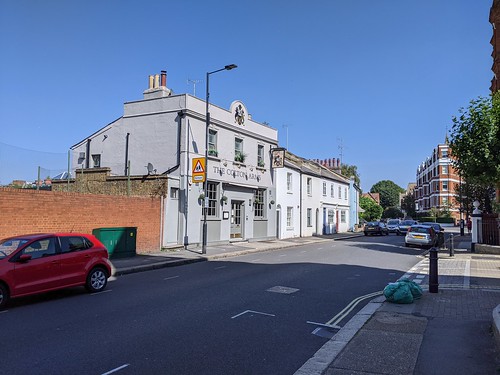 |
Out of the cemetery and down Field Road, passing on the left a large brick building,
one of the Covered Tennis courts of the Queens Club. The club founded in 1886 is
named after Queen Victoria, its first patron and
was the world’s second multipurpose sports
complex. It now has 28 outdoor courts and 8
indoor. It is also the national headquarters of
real tennis, rackets, and squash. Left into Greyhound Road, opposite Tasso Baptist Church (1887), and continue along to, on the left, The Colton Arms (1855), is a much loved very local pub, once considered to be the smallest pub in London. It doesn't look particularly small to me, maybe it's been extended? Unfortunately it wasn't open. |
|||
  |
On the right, is Queens Club Gardens
(W.H.Gibbs, 1894). It consists of 33 blocks of mansion flats named after
literary and historical figures in alphabetical order –Arnold – Zenobia (three in
Greyhound Road). Advertisements for the new apartments described modern amenities such as ‘kitcheners’ (coal-fired ranges with oven and back boilers to [8]provide hot water) sculleries, coal bunkers, larders, ‘sumptuous decoration, gas lighting, electric bells, venetian blinds and fireproof stair cases. The garden in the centre is private. These are very ornate mansion flats with some nice details such as the lamps at the entrances. Walk around 3 sides of gardens and out into Normand Road turn left and then left then right into St Andrews Road Yeah, these instructions don't work too well. Turn left out of Normand Rd. into Greyhound Rd. The church is opposite and the path is to the right of the church at this point, take the path and you come out by the former vicarage behind the church in St. Andrews Road. |
|||
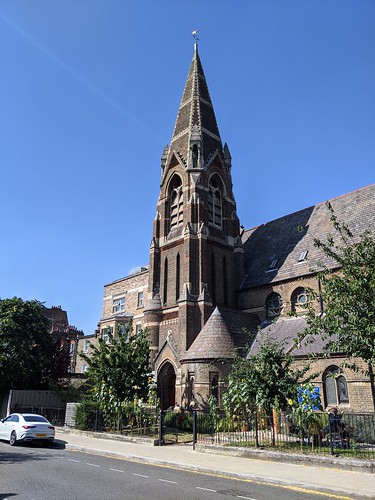  |
St Andrews Church (1837-4
Newman & Billing, enlarged
1894-6 Aston Webb). If
open,(It wasn't today as far as I could tell.) do go in as the
Sanctuary is magnificent
and there is an Arts & Crafts
stained glass window in the SE
Chapel by Paul Woodroffe
(1902). Take the path on the right of the Church (see above) and walk through to look at the former very handsome vicarage, now converted to flats. |
|||
  |
Continue ahead and at the end of the path turn right into Perham Road and turn right continuing to Challoner Crescent. Note Studio 3 Challoner Crescent (1899) – an eccentric building put to use for or by an artist. | |||
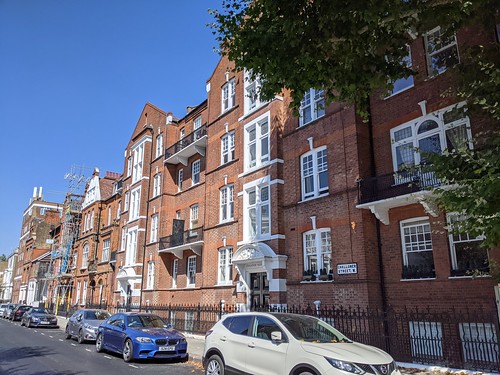  |
Turn back up Challoner Street and on the right
note Nos 1-4 (Francis L.Pither 1887) Aesthetic movement houses, possibly built as
studios. Further up, on the corner of Castleton Road, is The Bhavan Centre, formerly the West Kensington Congregational Church (James Cubitt, 1882-5). It is now an Institute of Indian Culture, the largest centre for Indian Arts and Culture outside India . The institute moved to here in 1978. 800 students a week pass through its doors. Details of courses and events can be found on its website bhavan.net |
|||
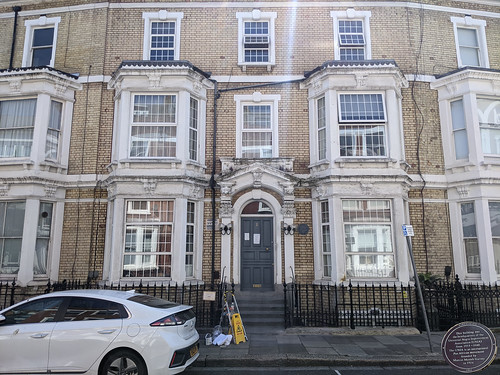 |
Turn right into Castleton Road and carry on to North End Road. Cross and turn right into Beaumont Crescent, where at No 2 there is a blue plaque to Marcus Garvey (1887-1940), who founded the Universal Negro Improvement Association in 1914 | |||
 |
Back to the North End Road and turn
right towards the Talgarth Road, passing
the Famous 3 Kings Pub (1902), with
its splendid arched glazed entrance. The pub was known as Nashville in the 1970’s and was a venue where the Sex Pistols played. It is now promoted as “London’s best sports pub’ with multiple screens. Which was enough to stop me going in even though this one was open. |
|||
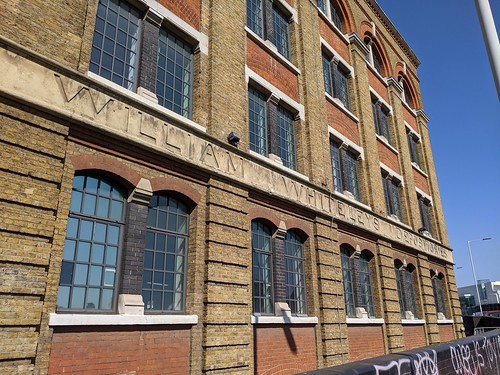
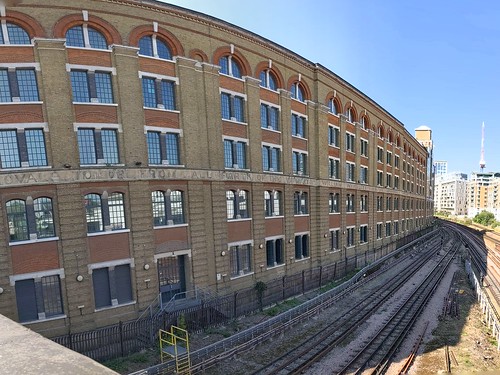
|
Cross (the still incredibly busy) Talgarth Road turn right and head for the bridge,(over the railway) where along on the left you
will see the Whiteley’s warehouse along the railway, Whiteleys Repository,
(1892-1901 Alfred Ridge). Originally Whiteleys Depository and Laundry. These
warehouses supplied Whiteleys department store in Queensway. This store at the time had no serious rival in London. The Whiteley slogan was ‘Everything from a pin to an elephant’ for sale under one roof. Whiteley, who had himself a colourful ‘rags to riches’ story, was shot dead in 1907 by someone who claimed to be his son. The family finally sold the business to Selfridges in 1927. The handsome repository buildings have an industrial appearance and are especially impressive seen from the railway below. The area also contains a laundry block and stables as well as the 5 storey warehouse. |
|||
  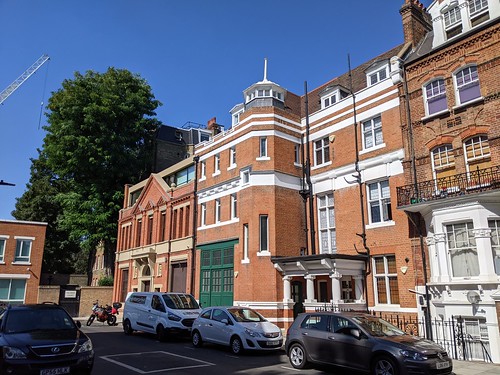 |
Walk back along Talgarth Road and descend the ramp to Mornington Avenue turn
right into Matheson Road and at the end is Avonmore Road. Turn right to look at the main entrance to the Whiteley’s buildings at the end. Turn back along Avonmore road, and on the left at 51, Plaque to Sir Edward Elgar 1889. I wonder if people with blue plaques to the very famous on their homes ever get pissed off with people taking photos? On the right Sir Compton Mackenzie lived at No 54. 22 Avonmore Road. Listed built 1888-9 by James Maclaren for the sculptor H R Pinker in Arts and Crafts style as his home and studio. 22A Avonmore Road is a working studio. Kenneth Armitage a British sculpture known for his abstract semi-bronzes lived here until his death in 2002. The house is now part of the Kenneth Armitage Foundation. The foundation makes an award of a fellowship which provides for an annual stipend and the use of the studio and residence. Alongside, 20 Avonmore Road has plaques VR & 1887 and is possibly a former Post Office. |
|||
 |
8 Avonmore Road – Studio House, c1880 was in 1891 the
home of William Lockhart who was commissioned by Queen
Victoria to paint her Jubilee celebrations. The picture now hangs in
Windsor Castle. In 1895 the portrait painter Edward Fellowes Prynne appears on the voters register. Later occupied in 1949-57 by Gavin Maxwell, author of The Ring of Bright Water. |
|||
  |
Retrace your steps back to where you turned out of Mornington Road, carry on along
North End Crescent to North End Road. Cross North End Road and turn right into Gwendwr Rd. Gwendwr Gardens Park opened in 1949. In 1948 the area was donated to Fulham Council by the Gunter Estate for a memorial to the victims of German air raids in the area, particularly the Operation Steinbock raid on the night of 20 February 1944.There is an ornamental sunken garden, pond and tall shady trees. Which were particularly welcome at this point although most of the other occupants were determinedly soaking up the late summer UV radiation. |
|||
| Go back to North End Road, turn right and cross Talgarth Road. West Kensington
Station is on your left. Although first I took a walk up to Holland park because public conveniences are like hen's teeth in this part of London. There I managed at least to also get a coffee before the cafe closed promptly at half past three despite having a park full of potential thirsty customers. Only in England. |
||||
| With thanks to The Fulham Society Maya Donelan and Barbara Skorupska who
conceived and compiled this walk in collaboration with Open House. The dates, facts etc. about the places passed on the tour are theirs, the photos are mine. Of course it doesn't have to be Open House Festival week to do this walk and the guide, along with those for other Fulham walks, can be found here on The Fulham Society web site. |
No comments:
Post a Comment